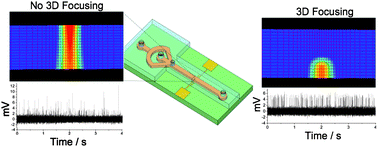In this paper, we present a device to electrically count blood cell populations using an AC impedance interrogation technique in a microfabricated cytometer (microcytometer). Specifically, we direct our attention to obtaining the concentration of human CD4+ T lymphocytes (helper T cells), which is a necessary method to diagnose patients for HIV/AIDS and to give an accurate prognosis on the effectiveness of ARV (anti-retroviral) drug treatments. We study the effectiveness of a simple-to-fabricate 3-dimensional (3D) hydrodynamic focusing mechanism through fluidic simulations and corresponding experiments to increase the signal-to-noise ratio of impedance pulses caused by particle translocation and ensure lower variance in particle translocation height through the electrical sensing region. We found that the optimal 3D sheath flow settings result in a 44.4% increase in impedance pulse signal-to-noise ratio in addition to giving a more accurate representation of particle size distribution. Our microcytometer T cell counts closely with those found using an industry-standard flow cytometer for the concentration range of over three orders of magnitude and using a sample volume approximately the size of a drop of blood (∼20 µL). In addition, our device displayed the capability to differentiate between live and dead/dying lymphocyte populations. This microcytometer can be the basis of a portable, rapid, inexpensive solution to obtaining live/dead blood cell counts even in the most resource-poor regions of the world.

You have access to this article
 Please wait while we load your content...
Something went wrong. Try again?
Please wait while we load your content...
Something went wrong. Try again?


 Please wait while we load your content...
Please wait while we load your content...